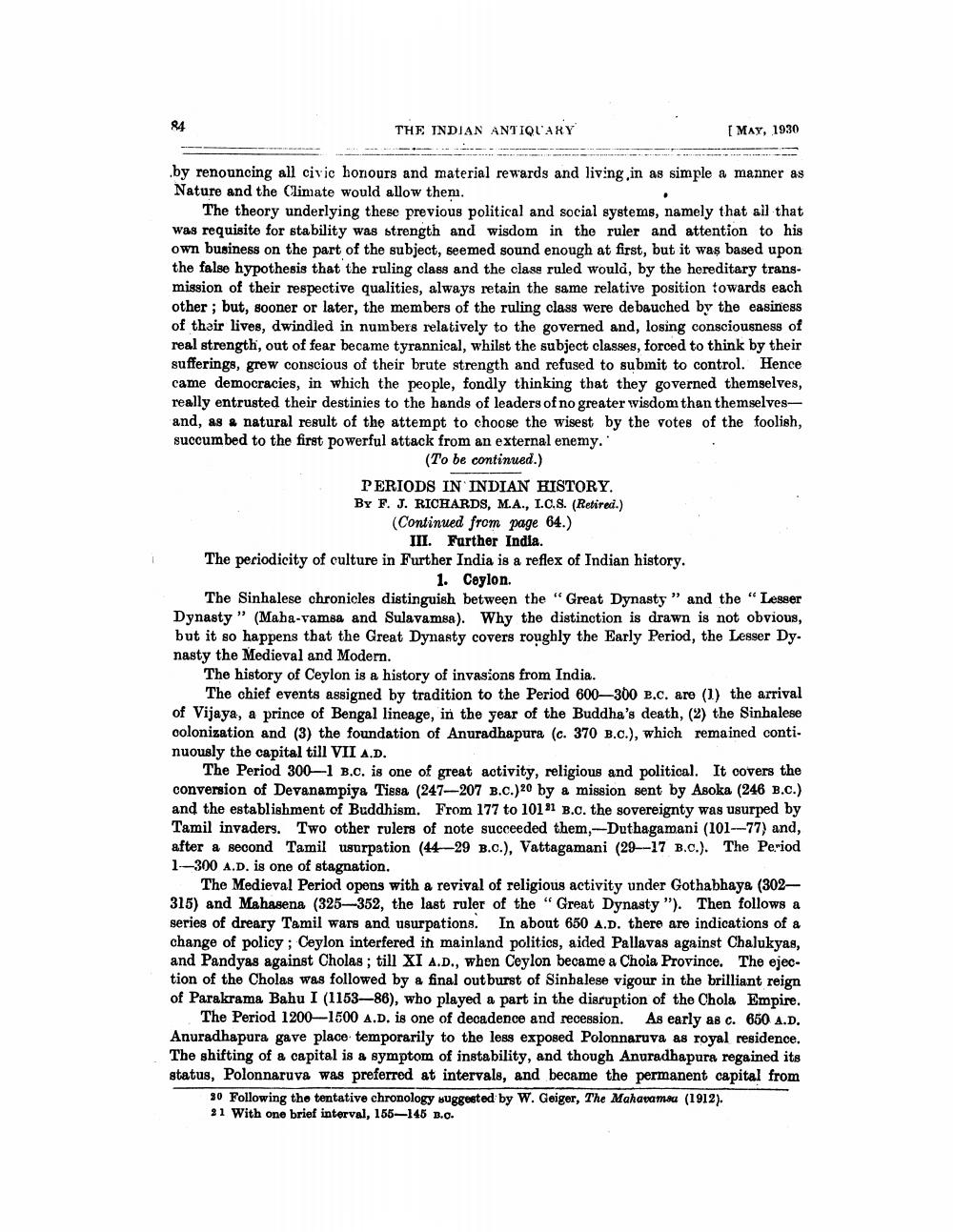________________
84
THE INDIAN ANTIQLARY
(May, 1930
.by renouncing all civic honours and material rewards and living in as simple a manner as Nature and the Climate would allow them.
The theory underlying these previous political and social systems, namely that ail that was requisite for stability was strength and wisdom in the ruler and attention to his own business on the part of the subject, seemed sound enough at first, but it was based upon the false hypothesis that the ruling class and the clase ruled would, by the hereditary transmission of their respective qualities, always retain the same relative position towards each other ; but, sooner or later, the members of the ruling class were de bauched by the easiness of their lives, dwindled in numbers relatively to the governed and, losing consciousness of real strength, out of fear became tyrannical, whilst the subject classes, forced to think by their sufferings, grew conscious of their brute strength and refused to submit to control. Hence came democracies, in which the people, fondly thinking that they governed themselves, really entrusted their destinies to the hands of leaders of no greater wisdom than themselvesand, as e natural result of the attempt to choose the wisest by the votes of the foolish, succumbed to the first powerful attack from an external enemy.'
(To be continued.) PERIODS IN INDIAN HISTORY. By F. J. RICHARDS, M.A., I.C.S. (Retired.)
(Continued from page 64.)
III. Further India. The periodicity of culture in Further India is a reflex of Indian history.
1. Ceylon. The Sinhalese chronicles distinguish between the “Great Dynasty " and the "Lesser Dynasty" (Maba-vamsa and Sulavamsa). Why the distinction is drawn is not obvious, but it so happens that the Great Dynasty covers roughly the Early Period, the Lesser Dy. nasty the Medieval and Modern.
The history of Ceylon is a history of invasions from India.
The chief events assigned by tradition to the Period 600—300 e.c. are (1) the arrival of Vijaya, a prince of Bengal lineage, in the year of the Buddha's death, (2) the Sinhalese oolonization and (3) the foundation of Anuradhapura (c. 370 B.C.), which remained continuously the capital till VII A.D.
The Period 3001 B.c. is one of great activity, religious and political. It covers the conversion of Devanampiya Tiesa (247—207 B.C.)20 by a mission sent by Asoka (246 B.C.) and the establishment of Buddhism. From 177 to 101 21 B.c. the sovereignty was usurped by Tamil invaders. Two other rulers of note succeeded them,-Duthagamani (101--77) and, after a second Tamil usurpation (44-29 B.C.), Vattagamani (29-17 B.C.). The Period 1-300 A.D. is one of stagnation.
The Medieval Period opens with a revival of religious activity under Gothabhaya (302315) and Mahasena (3254352, the last ruler of the "Great Dynasty "). Then follows a series of dreary Tamil wars and usurpations. In about 650 A.D. there are indications of a change of policy ; Ceylon interfered in mainland politics, aided Pallavas against Chalukyan, and Pandyas against Cholas; till XI A.D., when Ceylon became a Chola Province. The ejection of the Cholas was followed by a final outburst of Sinbalese vigour in the brilliant reign of Parakrama Bahu I (1153—86), who played a part in the disruption of the Chola Empire.
The Period 1200-1500 A.D. is one of decadence and recession. As early as c. 650 A.D. Anuradhapura gave place temporarily to the less exposed Polonnaruva as royal residence. The shifting of a capital is a symptom of instability, and though Anuradhapura regained its status, Polonnaruva was preferred at intervals, and became the permanent capital from
30 Following the tentative chronology suggested by W. Geiger, The Mahavamsa (1912). 21 With one brief interval, 155—145 B.O.




